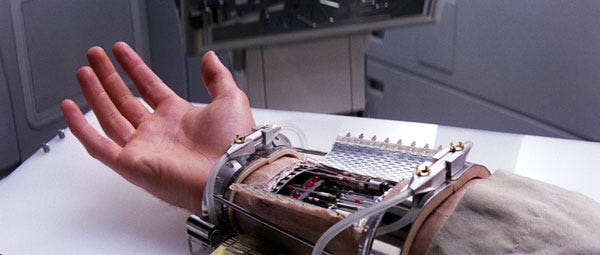Luke Skywalker Prosthetics in a Decade?
February 4, 2016
A new Department of Defense program will roll out $60 million to fund technologies designed to measure and record one million neurons simultaneously. One researcher involved in the project says the research could lead to Star Wars-type prosthetics within 10 years.
Kristopher Sturgis
A DARPA project will seek to develop brain-computer interfaces that can stimulate
100,000 neurons in the brain. Image from Wikia.
The future of neuroscience will be the focus this week as a bevy of neuroscientists gather in Arlington, VA to discuss the requirements of a new government program titled, "Neural Engineering System Design." The program will be carried out by DARPA as part of President Obama's BRAIN Initiative, and will look to develop a device that can stimulate 100,000 neurons in the human brain.
The initiative also laid out plans to develop technologies that can record one million neurons simultaneously within the next four years. Other requirements include developing a capable technology that is wireless, and mandates that all electronics fit inside a package no larger than a nickel. Perhaps most importantly, the device must also meet all safety requirements necessary to carry out studies on human subjects.
The technology could lead to the development of Luke Skywalker-type prosthetic devices within a decade as well as a better understanding of how the brain calculates, according to Konrad Kording, a data scientist at Northwestern University who authored a paper featured in Nature Neuroscience on the subject.
This final requirement shows an intent by DARPA to draw in interest from the medical device sector, as well as manufacturers of semiconductors and optical instruments. With industry involvement there is hope that brain-machine interface technologies could take off in a similar fashion to computer technologies in the 90s.
It's clear the agency has set lofty goals for the initiative, as DARPA works toward establishing a complete neural circuit and record from every neuron. Up until now scientists have mostly been limited to measuring neuronal activity through electrodes, often times limiting them to recording and measuring only one neuron at a time.
Progress in neuroscience has been relatively slow relative to that of other fields. The number of simultaneously recorded neurons has been shown to double roughly every seven years. "This is a glacial speed relative to Moore's law," Kording says. The slow speed is a result of the community has accepted trying to double the number of simultaneously recorded every roughly seven years as opposed to upping the stakes to 1000x. "At the moment, PhD students solder each channel," Kording says. "But in electronics they use foundries and very high densities. All automatic. Neuroscience needs to learn from microfabrication field; your phone has more transistors than all electrodes that have ever been produced in neuroscience."
The NIH funding Kording's group received will help the team of researchers adapt existing technologies in imaging chip/processor design.
Recently advancements have been made, however, by teams trying to develop brain-machine interfaces for patients who have been left paralyzed. Scientists at several different universities have managed to use an array of sharp silicon needles to record anywhere from 200 to 300 neurons at once inside the human brain. These studies have provided scientists with a rudimentary understanding of how humans think about simple arm and hand motions, enabling them to use those signals to move a robotic arm.
Kording says that movement is distributed over millions of neurons across different brain areas. He estimates that we need to measure at least 1000 times more neurons to be able to produce a high quality prosthetic device.
This is where the new DARPA initiative could make a difference. With $60 million set aside to help scientists devise new methods to create technologies that enable researchers to observe and record more neurons at one time, the initiative could be be a boon for the future of neuroscience research. With increased human studies on the horizon, there's no telling how far the DARPA initiative could push brain-computer interface technologies, but it's certainly worth keeping eye on as this area of research progresses.
When asking what are the main challenges his group could face, Kording lists not mincing the brain, making electrodes thinner, and data processing. "We need better algorithms and ways of thinking," he says. "We have no idea yet how to make sense of the data."
Brush up on your medical device materials knowledge at MD&M West, February 9-11 at the Anaheim Convention Center in Anaheim, CA. |
About the Author(s)
You May Also Like




.png?width=300&auto=webp&quality=80&disable=upscale)
